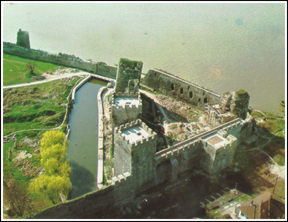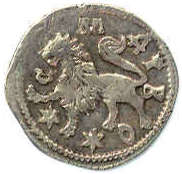Serbian Medieval History
Djuradj Brankovic (1427 - 1456)
![]() The long reign of despot Djuradj (pr. JOO-raj; George) Brankovic was rich and eventful - including many tragic moments which he valiantly countenanced until his last days - and destiny indeed made of him one of the most eminent European personalities of his era.
The long reign of despot Djuradj (pr. JOO-raj; George) Brankovic was rich and eventful - including many tragic moments which he valiantly countenanced until his last days - and destiny indeed made of him one of the most eminent European personalities of his era.
Immediately upon assuming the throne after the death of his uncle despot Stefan, in accordance with the latter's agreements with Hungarians, Djuradj had to restore Macva and Belgrade to them; and the fortress of Golubac surrendered to the Turks. Before his death, despot Stefan was obliged to surrender, also, Nis and Krusevac. Pressed from two sides, Djuradj decided to renew the vassal contract with Murad II. Deprived of several important towns and desperately in need of capital, Djuradj managed to build a new, well-fortified city on the Danube - Smederevo - in only two years; its monumental walls and towers, despite heavy damage in the two world wars, largely remain to this day.
![]() SILVER ASPRA, minted in Smederevo
SILVER ASPRA, minted in Smederevo
With the main construction complete in 1430, he transferred to Smederevo his court and the main money mint. Likewise, Smederevo replaced Belgrade as the seat of the metropolitan. In a very short time, the new capital obtained somewhat of the glory of a "new Constantinople", its Christian reputation enhanced by events like the transfer of St. Luke the Apostle's relics to the city. The court functioned through two chancelleries, the Serbian and Latin ones. The city was also inhabited by Serbian and Dubrovnik aristocracy.
Despite some initial setbacks, Djuradj still possessed a large and rich state - his Despotate extending from the Sava and Danube rivers to the Adriatic coast. Its neighbors were Turkey, Hungary (with its vassal Bosnia), and Venice; at this point, the Byzantine Empire was no longer geographically adjacent to Serbia. The political approach towards the West did not, however, mean any break with the Byzantine culture - on the contrary, common perils made political ties between Serbia and the Byzantium as strong as ever. At the same time, the negotiations which brought the Byzantine emperor John VIII Palaiologos to conclude the Florentine union of the two churches (1439) did not result in any significant Western help.
As early as 1438, Murad II made major forays into Serbian territories, and destroyed several important fortifications, together with the Ravanica monastery. Next year he besieged Smederevo, which, faced with supply limits, eventually surrendered along with most of the state - thus marking what was the first fall of Serbia. In 1440 came the first Turkish siege of Belgrade, but the invaders were defeated now and forced to withdraw. In the meantime, despot Djuradj tried to have Hungary mobilize Christian forces, but he was baffled due to the confusion which arose following the death of the Hungarian king and emperor Sigismund I in 1437, and the subsequent quarrels around the Hungarian throne. Finally, in 1443 Djuradj with his Serbian forces joined the grand crusade led by king Ladislas and the Hungarian nobleman Janos Hunyady (known as Sibinjanin Janko in Serbian epic poetry). The Ottomans were defeated several times, allowing by the next year Djuradj to successfully recover his state, as the Turks were obliged to restore all his possessions with 24 cities. But in another crusade, which the despot this time avoided, later that same fall, in the battle near Varna (Bulgaria), the Christians were routed and king Ladislas and cardinal Cesarini killed, with Hunyady barely managing to escape. In his revenge campaigns against the Turks in autumn 1448, Hunyady ravaged through Serbia and was defeated by the Turks in the second Kosovo battle. The despot's position was this time strengthened by neutrality, allowing him a position of mediator in the 1451 peace contract between the Turks and Hungary.
However skillfully Djuradj may have navigated these troubled political waters, the end was nevertheless near. The new sultan Mehemmed II (1451-1481) "The Conqueror", shortly after his accession besieged and finally took in 1453 Constantinople - the last significant remnant, and crucial symbol of the Byzantine empire. Having earlier generously supplied resources to repair portions of its walls, he was now obliged to supply vassal troops to aid the sultan in pounding and scaling them. In the meantime, Djuradj's diplomatic action, initiated in several Italian towns, had no concrete answer. In 1455 Turks conquered the key mining center of Novo Brdo, massacring its inhabitants after the fall. The following year they tried to conquer Belgrade again, and once more were defeated - the sultan himself having been wounded in the process. But that same fall saw the deaths of two most distinguished 15th-century crusaders - Janos Hunyady in Belgrade, and despot Djuradj in Hungary. Djuradj had four sons, three of whom were blinded by the Ottomans, and his daughter Mara had been married to Murad II, living in the Turkish harem until his death. Djuradj was succeeded by his son Lazar, who unfortunately died already in January 1458.
Deprived of a serious government, demoralized and abandoned, Serbia proper was finally conquered by the Turks in 1459, when its last major outpost and capital, Smederevo, was surrendered - this time without a fight. In the final decades of the 15th century, the invaders would gradually eliminate the relative autonomy of the remaining Serbian lands: Bosnia (1463), Hercegovina (1481), and Zeta (1496). The heirs to the Brankovic family took refuge in Hungary, where they continued to play a significant role in the anti-Turkish struggle for some time.
TIMELESS WALLS The formidable walls of Smederevo jealously protected the short but significant rise of the city as one of the last beacons of Eastern Christendom before the sweeping Islamic tide. "The ancient walls of Djuradj's city will stand here for many centuries to come, calmly reflecting in the blue Danube waters, proudly resisting both time and new conquerors, and proving the prowess of medieval Serbian builders and masons", wrote reserve officer Zivorad Nikic on October 14, 1915, making his last stand against the German invasion.
The formidable walls of Smederevo jealously protected the short but significant rise of the city as one of the last beacons of Eastern Christendom before the sweeping Islamic tide. "The ancient walls of Djuradj's city will stand here for many centuries to come, calmly reflecting in the blue Danube waters, proudly resisting both time and new conquerors, and proving the prowess of medieval Serbian builders and masons", wrote reserve officer Zivorad Nikic on October 14, 1915, making his last stand against the German invasion.

Others
More Information
BLAGO Content
While the content of the BLAGO Fund collections is free to use, there are also some restrictions on commercial use and proper attribution of the material. Follow the links below for more information.
> BLAGO Collections License
> Image Request
BLAGO Fund also accepts the contribution of material. Please contact us with any material you wish to publish on our website.
Contact
BLAGO Fund, Inc.
PO Box 60524
Palo Alto, CA 94306
USA
info@blagofund.org

